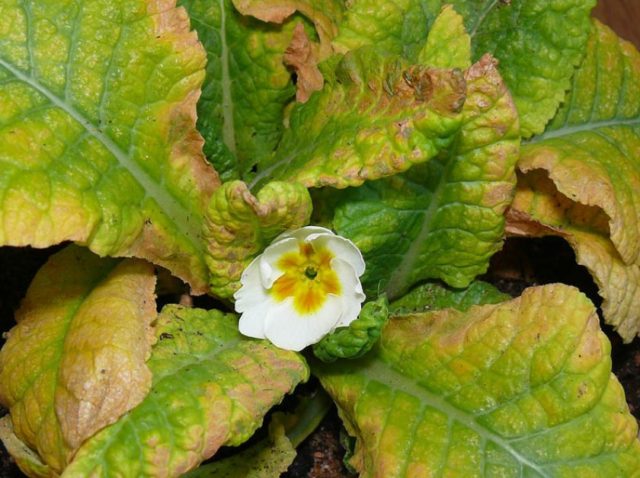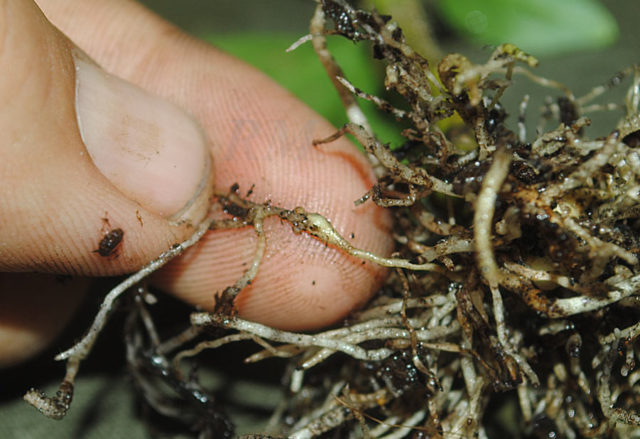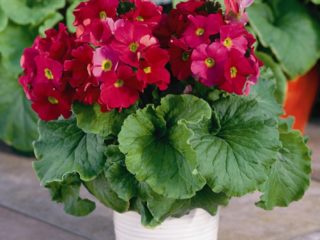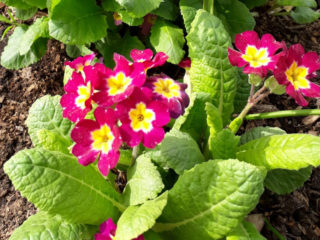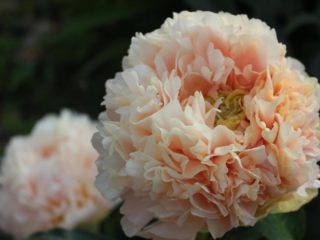Content
Small-toothed primrose is an ornamental plant with beautiful spherical inflorescences, the flowering period of which begins in April. Low bushes, which do not require special care, become a good decoration for a personal plot.
Description of fine-toothed primrose
Small-toothed primrose is a perennial plant belonging to the genus Primroses. The leaves of the species are oval, wrinkled, have small notches at the edges and reach a size of 30-40 cm by the end of the flowering period. Flowers are characterized by the presence of a jagged edge, for which, in fact, the plant got its name.
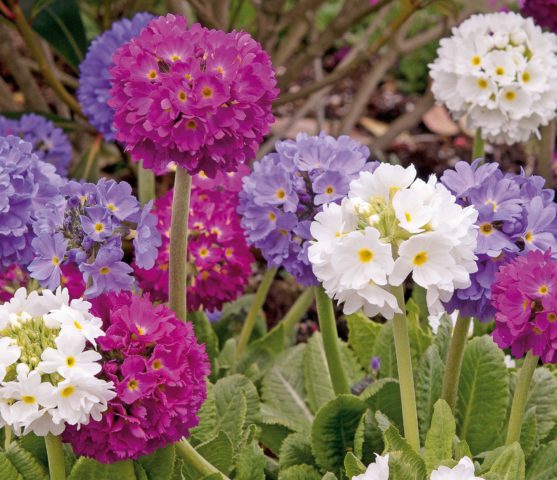
Small-toothed primrose can be a decoration of any garden plot
Globular inflorescences in most cases have a lilac hue. Less common are white, yellow, blue, pink and red flowers. The peduncles are thick, and this is not surprising, because they have to keep an inflorescence about 10 cm in diameter. In their upper part there is a rosette consisting of oblong wrinkled lanceolate leaves.
It is noteworthy that the foliage of the primrose is formed together with the peduncle and reaches its maximum size by the time the seeds ripen.
The plant blooms in April-May, the total budding period is about 40 days. During blooming, the species reaches 10-25 cm in height, but some varieties grow up to 50-60.
In the Russian latitude, perennial primroses are most often grown. However, there are one- and two-year-old species.
Despite its modest appearance, the primrose is popular with gardeners. Maybe because one of the first pleases with its bright colors.
Fine-toothed primrose varieties
There are several plant varieties: fine-toothed primrose Pon Pon, Alba, Bugle and others that differ from each other in appearance. Each of them will be described in more detail below.
Alba
Small white flowers (about 1.5 cm in diameter) of the Alba variety are formed into larger inflorescences up to 10 cm in size. The height of the bush at the beginning of flowering is 20 cm, by the time of seed ripening it increases to 50. Flowering time - from mid-April to early June ... Alba fine-toothed primrose loves moisture and partial shade.
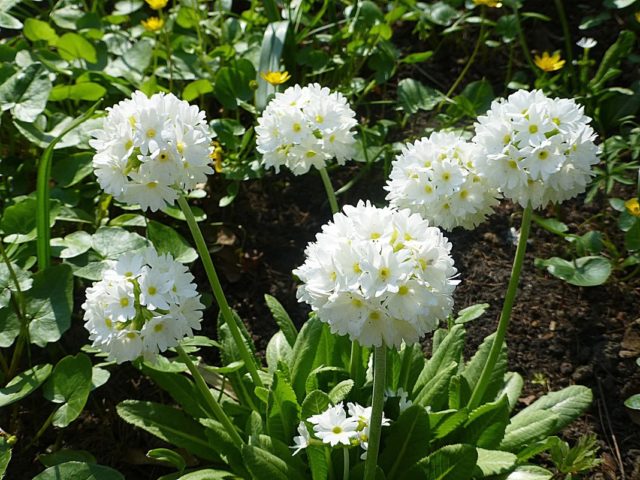
Alba primrose inflorescences reach 10 cm in size
Ruby
Small-toothed primrose Ruby is remarkable in that it has bright red or pink flowers, reaching 6 cm in diameter. By the way, thanks to their color, the flower got its name. The plant can be an ideal solution for decorating curbs or the banks of an artificial reservoir. Looks good in the vicinity of tall shrubs. Rubin pleases with its flowers from April to June.
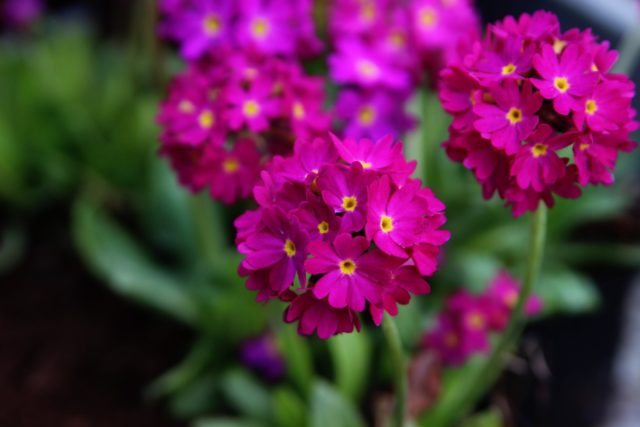
Primrose Ruby can be the perfect decoration for curbs and natural pond
Violet
Based on the name, you can guess what shade the flowers of this plant have. Violet's inflorescences are not as large as some other species. However, the bright purple flower heads stand out especially in the flower bed. The flowering time, like all varieties, is from April to June.

Purple primrose flowers Violet will look good on the garden lawn
Bugle
The characteristic difference between the Bugle primrose and other varieties is the presence of large, powerful leaves with a relatively low plant height (about 35 cm). Flowers come in different shades: pink, yellow, white, purple, blue.

Bugle primrose flowers can be of different colors.
The flowering period, like other primroses, lasts from April to June.
Ed
This is a very beautiful plant with bright red flowers without impurities, collected in spectacular inflorescences in the shape of a ball. Small-toothed primrose Red loves moist shaded areas. Red blooms from April to June.
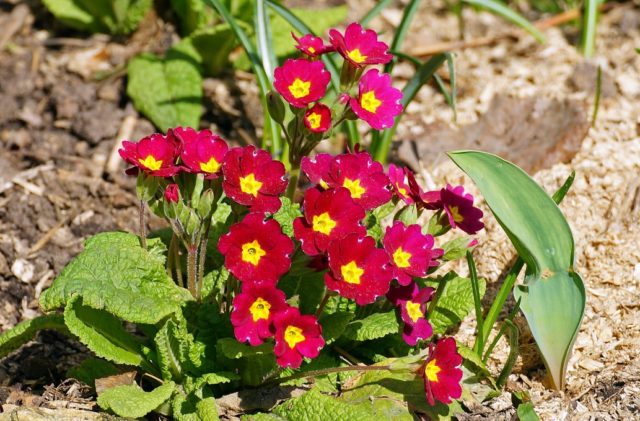
Primula Red loves wet and shaded areas.
Pink
Small-toothed pink primrose bushes grow up to 20-25 cm. The small pink flowers of Pink form into round inflorescences with a diameter of about 15 cm.
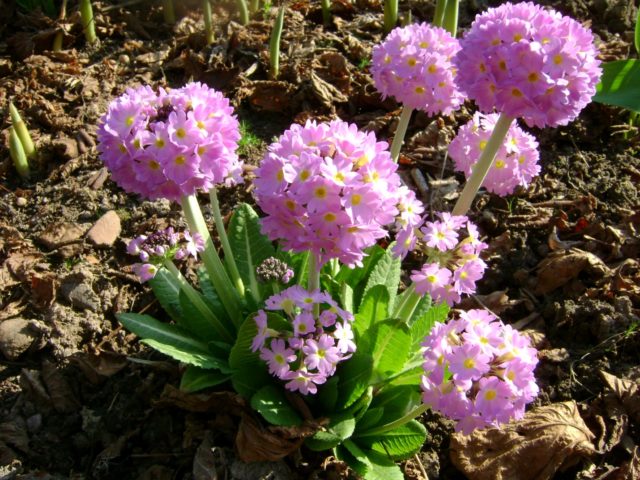
Primula Pink is a short plant with large balls of inflorescences
Application in landscape design
There are areas not too sunlit, probably, in any garden. Places near a fence, a wall or in the shade of trees are the best suited for growing primroses.
A primrose can be a decoration of any site - a curb, the coast of a reservoir, a lawn, an alpine slide or a garden flower bed. And primroses in pots are a good option for decorating a gazebo, porch, balcony or staircase.
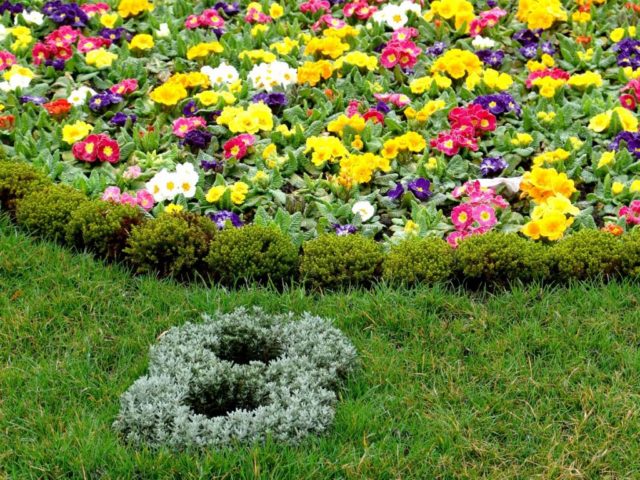
Primrose can be a decoration of the lawn
Plants with similar preferences are placed next to the primrose, that is, those that love shade and moisture. The best neighbors are hosta, astilba, fern.
Planting and caring for fine-toothed primrose
Primrose is an unpretentious plant, so even a novice gardener can grow it. Nevertheless, you should still know some of the subtleties of reproduction of this beautiful flower and its care.
A prerequisite for the normal development of primrose is the presence of a soil rich in humus. For a houseplant, you can buy a ready-made composition or make it yourself by mixing in equal parts sand, peat and black soil. And for gardening, it is better to use soil that contains home compost and organic fertilizers, in particular, matured cow dung.
Clay soils are not suitable for growing primroses, but if you still have to use them, you need to drain vermiculite or perlite, which are placed at the bottom of a hole or flower pot under a layer of earth.
Primrose loves moisture, therefore, ideally, plant it near a reservoir - a stream or an artificial pond on the site. If this is not possible, the plant will have to be watered more often: at least 3 times a week in cool weather and every day in hot weather.
There are two ways to propagate small-toothed primrose: cuttings and seeds.
Seeds can be sown either in a container with subsequent transplantation of the plant, or directly into open soil.
In the process of sowing seeds into a container:
- lay them out on cotton pads placed in containers with low sides;
- each disc is covered with another and sprayed with water, the seeds should be moist, but not wet;
- sprouted seed is planted in a seedling container.
The pick is done after the appearance of the first three sheets. Each bush is transferred to a separate container for rooting and subsequent development.
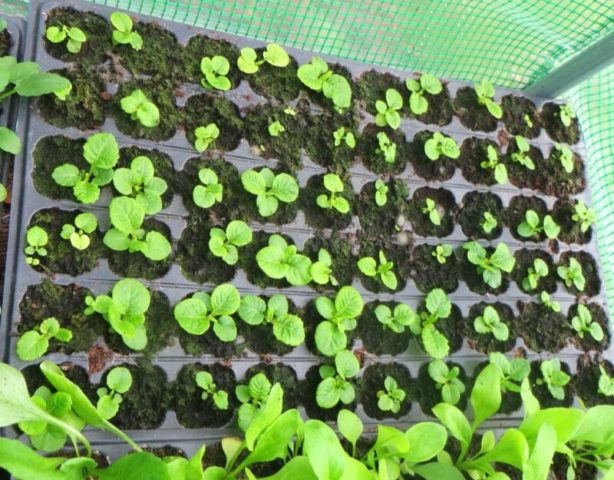
Primrose dive after the appearance of the third leaf
Sowing seeds in open soil is carried out as follows:
- make a hole in the soil about one and a half centimeters deep;
- spread the seeds as close to each other as possible;
- cover the hole with soil (the top layer should be no more than 2 cm);
- cover the bed with mulch, which is used as fallen leaves, sawdust, dry grass without seeds. The mulch layer should be about 5 cm.
Plants grown from seeds are transplanted to a permanent place after a year.
After three years of life, the appearance of primrose noticeably worsens - the leaves become thinner, and the inflorescences are smaller. This suggests that it is time to transplant the primrose. This is done after the flowering period.
During the transplant:
- water the plant abundantly;
- when the water is completely absorbed and the earth becomes soft, the primrose is dug up;
- wash off the dirt from the root and carefully divide it into 2-3 parts with a sharp knife;
- the cuts are sprinkled with wood ash;
- the separated shoots are transplanted to another place, a distance of 20-25 cm is left between the undersized bushes, and 35-40 between the tall ones;
- the soil between the bushes is covered with mulch.
Planting is better in the evening or in cool weather. It is not necessary to fill the bushes strongly.
Daily care of a garden flower is not difficult. All a primrose needs is regular watering, removing weeds, loosening the soil, fertilizing and protecting against pests.
If the soil is covered with a mulch layer, it is not necessary to loosen it. Weeds are removed as they emerge. Water as the soil dries up.
The first feeding with organic fertilizers is done at the beginning of the flowering period, and the second at the end.
In order for a room primrose to please with its flowering for as long as possible, you should:
- Observe the optimal temperature regime. The room should not be hot or cold. The optimum temperature for a plant is + 8-16 ° C.
- Water regularly. The flower loves moisture, so it will have to be irrigated 2-3 times every 7 days. If the air in the apartment is dry, it is recommended to spray the flowers with leaves every day.
- Provide proper lighting. A suitable place for a room primrose would be an area of the room with diffused light. Direct rays of the sun can be detrimental to the plant.
- Feed. Fertilizing a plant is a prerequisite for its normal development and flowering. Experts recommend fertilizing primrose 2 times: immediately after transplanting with organic fertilizers - bone meal, peat or compost, and after the end of the flowering period - with ammonium nitrate.
Indoor primrose can be planted at any time of the year. A month passes from the moment of planting to the appearance of the first flowers.
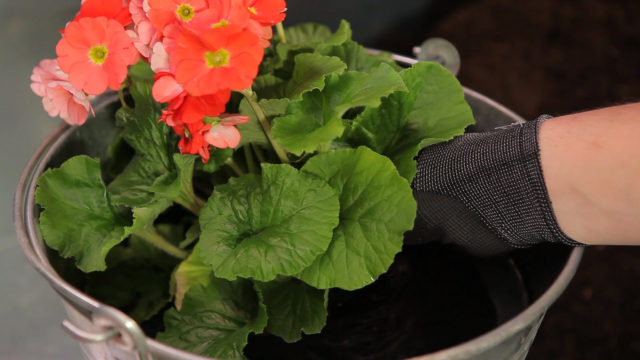
Indoor primrose can be planted at any time of the year
Wintering
The primrose is no longer afraid of the cold, but of temperature changes, so it is advisable to provide her with a comfortable winter. Snow is considered the best protection for a plant, but for the reason that it does not always happen in winter, primrose is covered with improvised material in the fall. The bushes are covered with a mixture of earth and fallen leaves, and covered with spruce branches on top.
Diseases and pests
Like any other plant, fine-toothed primrose can suffer from diseases and pests.
The most common diseases are:
- Rot. The characteristic symptom of this disease is dry or watery gray spots that first appear on the leaves and flowers, and then affect the stem and root system. The disease is dangerous for the plant and can lead to its death. At the initial stage, it is recommended to use the drugs Ridomil Gold or Alet for treatment.
With an advanced form of rot, treatment will not give a positive result, so the primrose will have to be destroyed
- Spotting. This disease is characterized by the appearance of yellow-brown spots on the leaves, surrounded by a transparent bloom. Fungicidal preparations Fitosporin-M or Alirin-B will help to cope with this problem.
If the disease is ignored, the affected plant will turn black and die.
- Nematode. The development of this disease leads to deformation of the shoots and roots of primrose. The plant becomes lethargic, pineal formations appear on the roots.
It is impossible to cure the nematode, so the plant will have to be destroyed.
The list of pests that love primrose includes spider mites, thrips, aphids, weevils, and snails.
You can cope with uninvited guests by treating the plant with insecticidal preparations "Aktara", "Ampligo", "Confidor". A soapy solution is suitable for home remedies. You can get rid of snails using wood ash, which is used to cover the ground near the bushes.
Conclusion
Small-toothed primrose is a plant, the love for which among gardeners grows with an increase in the number of specimens in the garden. And this is not surprising, because they are all very beautiful. And the versatility and unpretentiousness of the garden beauty only fuel interest. Therefore, a good option is to plant this flower in your garden, especially since caring for it will not take much time.

